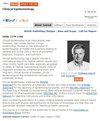急性淋巴细胞白血病治疗后的工作残疾和重返工作岗位:丹麦全国队列研究
IF 3.4
2区 医学
Q1 PUBLIC, ENVIRONMENTAL & OCCUPATIONAL HEALTH
引用次数: 0
摘要
目的:大多数确诊为急性淋巴细胞白血病(ALL)的成人患者都不到退休年龄。随着受儿科启发的高强度治疗方案的实施,急性淋巴细胞白血病患者的总体生存率有所提高。然而,这种治疗方法存在长期并发症的风险,可能会影响患者的工作能力。本研究旨在调查ALL患者领取残疾抚恤金(DP)和重返工作岗位(RTW)的风险:丹麦国家急性白血病登记处对 2005 年至 2019 年间确诊为 ALL 的 18-60 岁患者进行了鉴定。根据出生年份、性别和夏尔森综合症指数,将每位患者与普通人群中的五位比较者进行配对。使用 Aalen-Johansen 估计器计算患者和参照者自指数日(定义为诊断后 1 年)起的 DP 累积风险,以及竞争事件(移植或复发、死亡、退休金或提前退休金)。累积发病率的差异采用格雷氏检验进行计算。RTW计算的是确诊前有工作的患者在指数日期后1年、3年和5年的比例:共纳入了 154 名 ALL 患者和 770 名匹配的比较者。与普通人群相比,ALL 患者的 5 年累积 DP 风险增加了 5 倍。指数日期后一年、三年和五年的复工率分别为 41.7%、65.7% 和 60.7%:结论:与普通人群相比,ALL 患者的 DP 风险显著增加。结论:与普通人群相比,急性淋巴细胞白血病患者的残疾抚恤金风险明显增加,指数日期五年后,急性淋巴细胞白血病患者的复工率为 60.7%。本文章由计算机程序翻译,如有差异,请以英文原文为准。
Work Disability and Return to Work After Treatment for Acute Lymphoblastic Leukemia: A Danish Nationwide Cohort Study
Purpose: Most adult patients diagnosed with acute lymphoblastic leukemia (ALL) are below retirement age. The overall survival of patients with ALL has improved with implementation of high intensity pediatric-inspired treatment protocols. However, this treatment comes with a risk of long-term complications, which could affect the ability to work. The aim of this study was to investigate the risk of disability pension (DP) and return to work (RTW) for patients with ALL.
Patients and Methods: Patients aged 18– 60 years diagnosed with ALL between 2005 and 2019 were identified in the Danish National Acute Leukemia Registry. Each patient was matched with five comparators from the general population on birth year, sex, and Charlson Comorbidity Index. The Aalen-Johansen estimator was used to calculate the cumulative risk of DP for patients and comparators from index date (defined as 1 year after diagnosis) with competing events (transplantation or relapse, death, retirement pension, or early retirement pension). Differences in cumulative incidences were calculated using Gray’s test. RTW was calculated as proportions one, three, and five years after the index date for patients holding a job before diagnosis.
Results: A total of 154 patients with ALL and 770 matched comparators were included. The 5-year cumulative risk of DP was increased fivefold for patients with ALL compared with the general population. RTW was 41.7%, 65.7%, and 60.7% one, three, and five years after the index date, respectively.
Conclusion: The risk of DP in patients with ALL increased significantly compared with the general population. Five years after the index date, RTW was 60.7% for patients with ALL.
Keywords: acute lymphoblastic leukemia, disability pension, return to work
Patients and Methods: Patients aged 18– 60 years diagnosed with ALL between 2005 and 2019 were identified in the Danish National Acute Leukemia Registry. Each patient was matched with five comparators from the general population on birth year, sex, and Charlson Comorbidity Index. The Aalen-Johansen estimator was used to calculate the cumulative risk of DP for patients and comparators from index date (defined as 1 year after diagnosis) with competing events (transplantation or relapse, death, retirement pension, or early retirement pension). Differences in cumulative incidences were calculated using Gray’s test. RTW was calculated as proportions one, three, and five years after the index date for patients holding a job before diagnosis.
Results: A total of 154 patients with ALL and 770 matched comparators were included. The 5-year cumulative risk of DP was increased fivefold for patients with ALL compared with the general population. RTW was 41.7%, 65.7%, and 60.7% one, three, and five years after the index date, respectively.
Conclusion: The risk of DP in patients with ALL increased significantly compared with the general population. Five years after the index date, RTW was 60.7% for patients with ALL.
Keywords: acute lymphoblastic leukemia, disability pension, return to work
求助全文
通过发布文献求助,成功后即可免费获取论文全文。
去求助
来源期刊

Clinical Epidemiology
Medicine-Epidemiology
CiteScore
6.30
自引率
5.10%
发文量
169
审稿时长
16 weeks
期刊介绍:
Clinical Epidemiology is an international, peer reviewed, open access journal. Clinical Epidemiology focuses on the application of epidemiological principles and questions relating to patients and clinical care in terms of prevention, diagnosis, prognosis, and treatment.
Clinical Epidemiology welcomes papers covering these topics in form of original research and systematic reviews.
Clinical Epidemiology has a special interest in international electronic medical patient records and other routine health care data, especially as applied to safety of medical interventions, clinical utility of diagnostic procedures, understanding short- and long-term clinical course of diseases, clinical epidemiological and biostatistical methods, and systematic reviews.
When considering submission of a paper utilizing publicly-available data, authors should ensure that such studies add significantly to the body of knowledge and that they use appropriate validated methods for identifying health outcomes.
The journal has launched special series describing existing data sources for clinical epidemiology, international health care systems and validation studies of algorithms based on databases and registries.
 求助内容:
求助内容: 应助结果提醒方式:
应助结果提醒方式:


